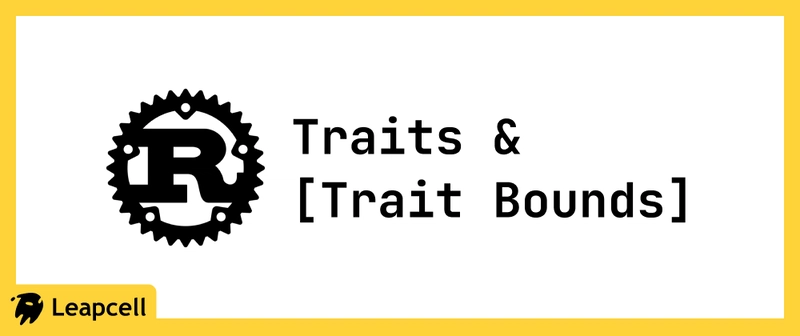Understanding Traits and Trait Bounds in Rust
A trait in Rust is similar to what’s often referred to as an “interface” in other programming languages, though there are some differences. A trait tells the Rust compiler that a specific type possesses functionality that may be shared with other types. Traits allow us to define shared behavior in an abstract way. We can use trait bounds to specify that a generic type must implement certain behaviors. Put simply, a trait is like an interface in Rust, defining the behavior a type must provide when implementing that trait. Traits can constrain behavior shared among multiple types, and when used in generic programming, can restrict generics to types that conform to the behavior specified by the trait. Defining a Trait If different types exhibit the same behavior, we can define a trait and then implement it for those types. Defining a trait means grouping a set of methods together with the goal of describing a behavior and set of requirements necessary to achieve some purpose. A trait is an interface that defines a series of methods: pub trait Summary { // Methods inside traits only need to be declared fn summarize_author(&self) -> String; // This method has a default implementation; other types don’t need to implement it themselves fn summarize(&self) -> String { format!("(Read more from {}...)", self.summarize_author()) } } This defines a trait named Summary that provides two methods: summarize_author and summarize. Methods in traits only need declarations; their implementation is left to specific types. However, methods can also have default implementations. In this case, the summarize method has a default implementation that internally calls summarize_author, which doesn’t have a default implementation. Both methods of the Summary trait take self as a parameter, just like methods on structs. Here, self is the first argument to the trait methods. Note: In fact, self is shorthand for self: Self, &self is shorthand for self: &Self, and &mut self is shorthand for self: &mut Self. Self refers to the type that implements the trait. For example, if a type Foo implements the Summary trait, then within the implementation, Self refers to Foo. pub trait Summary { fn summarize_author(&self) -> String; fn summarize(&self) -> String { format!("@{} posted a tweet...", self.summarize_author()) } } pub struct Tweet { pub username: String, pub content: String, pub reply: bool, pub retweet: bool, } pub struct Post { pub title: String, pub author: String, pub content: String, } impl Summary for Post { fn summarize_author(&self) -> String { format!("{} posted an article", self.author) } fn summarize(&self) -> String { format!("{} posted: {}", self.author, self.content) } } impl Summary for Tweet { fn summarize_author(&self) -> String { format!("{} tweeted", self.username) } fn summarize(&self) -> String { format!("@{} tweeted: {}", self.username, self.content) } } fn main() { let tweet = Tweet { username: String::from("haha"), content: String::from("the content"), reply: false, retweet: false, }; println!("{}", tweet.summarize()) } There is an important principle regarding where traits and their implementations may be defined, called the orphan rule: if you want to implement trait T for type A, then either T or A must be defined in the current crate. This rule ensures that code written by others won’t break your code, and likewise, your code won’t unintentionally break someone else’s. Using Traits as Function Parameters Traits can be used as function parameters. Here's an example of defining a function that uses a trait as a parameter: pub fn notify(item: &impl Summary) { // trait parameter println!("Breaking news! {}", item.summarize()); } The parameter item means "a value that implements the Summary trait." You can use any type that implements the Summary trait as the argument to this function. Within the function body, methods defined in the trait can also be called on the parameter. Trait Bounds The use of impl Trait above is actually syntactic sugar. The complete syntax is as follows: T: Summary, which is referred to as a trait bound. pub fn notify(item: &T) { // trait bound println!("Breaking news! {}", item.summarize()); } For more complex use cases, trait bounds provide more flexibility and expressive power. For example, a function that takes two parameters both implementing the Summary trait: pub fn notify(item1: &impl Summary, item2: &impl Summary) {} // trait parameter pub fn notify(item1: &T, item2: &T) {} // Generic T bound: requires item1 and item2 to be of the same type, and that T implements the Summary trait Specifying Multiple Trait Bounds Using + Besides single constraints, you can specify multiple constraints, such as requiring a parameter

A trait in Rust is similar to what’s often referred to as an “interface” in other programming languages, though there are some differences. A trait tells the Rust compiler that a specific type possesses functionality that may be shared with other types. Traits allow us to define shared behavior in an abstract way. We can use trait bounds to specify that a generic type must implement certain behaviors.
Put simply, a trait is like an interface in Rust, defining the behavior a type must provide when implementing that trait. Traits can constrain behavior shared among multiple types, and when used in generic programming, can restrict generics to types that conform to the behavior specified by the trait.
Defining a Trait
If different types exhibit the same behavior, we can define a trait and then implement it for those types. Defining a trait means grouping a set of methods together with the goal of describing a behavior and set of requirements necessary to achieve some purpose.
A trait is an interface that defines a series of methods:
pub trait Summary {
// Methods inside traits only need to be declared
fn summarize_author(&self) -> String;
// This method has a default implementation; other types don’t need to implement it themselves
fn summarize(&self) -> String {
format!("(Read more from {}...)", self.summarize_author())
}
}
- This defines a trait named
Summarythat provides two methods:summarize_authorandsummarize. - Methods in traits only need declarations; their implementation is left to specific types. However, methods can also have default implementations. In this case, the
summarizemethod has a default implementation that internally callssummarize_author, which doesn’t have a default implementation. - Both methods of the
Summarytrait takeselfas a parameter, just like methods on structs. Here,selfis the first argument to the trait methods.
Note: In fact,
selfis shorthand forself: Self,&selfis shorthand forself: &Self, and&mut selfis shorthand forself: &mut Self.Selfrefers to the type that implements the trait. For example, if a typeFooimplements theSummarytrait, then within the implementation,Selfrefers toFoo.
pub trait Summary {
fn summarize_author(&self) -> String;
fn summarize(&self) -> String {
format!("@{} posted a tweet...", self.summarize_author())
}
}
pub struct Tweet {
pub username: String,
pub content: String,
pub reply: bool,
pub retweet: bool,
}
pub struct Post {
pub title: String,
pub author: String,
pub content: String,
}
impl Summary for Post {
fn summarize_author(&self) -> String {
format!("{} posted an article", self.author)
}
fn summarize(&self) -> String {
format!("{} posted: {}", self.author, self.content)
}
}
impl Summary for Tweet {
fn summarize_author(&self) -> String {
format!("{} tweeted", self.username)
}
fn summarize(&self) -> String {
format!("@{} tweeted: {}", self.username, self.content)
}
}
fn main() {
let tweet = Tweet {
username: String::from("haha"),
content: String::from("the content"),
reply: false,
retweet: false,
};
println!("{}", tweet.summarize())
}
There is an important principle regarding where traits and their implementations may be defined, called the orphan rule: if you want to implement trait T for type A, then either T or A must be defined in the current crate.
This rule ensures that code written by others won’t break your code, and likewise, your code won’t unintentionally break someone else’s.
Using Traits as Function Parameters
Traits can be used as function parameters. Here's an example of defining a function that uses a trait as a parameter:
pub fn notify(item: &impl Summary) { // trait parameter
println!("Breaking news! {}", item.summarize());
}
The parameter item means "a value that implements the Summary trait." You can use any type that implements the Summary trait as the argument to this function. Within the function body, methods defined in the trait can also be called on the parameter.
Trait Bounds
The use of impl Trait above is actually syntactic sugar. The complete syntax is as follows: T: Summary, which is referred to as a trait bound.
pub fn notify<T: Summary>(item: &T) { // trait bound
println!("Breaking news! {}", item.summarize());
}
For more complex use cases, trait bounds provide more flexibility and expressive power. For example, a function that takes two parameters both implementing the Summary trait:
pub fn notify(item1: &impl Summary, item2: &impl Summary) {} // trait parameter
pub fn notify<T: Summary>(item1: &T, item2: &T) {} // Generic T bound: requires item1 and item2 to be of the same type, and that T implements the Summary trait
Specifying Multiple Trait Bounds Using +
Besides single constraints, you can specify multiple constraints, such as requiring a parameter to implement multiple traits:
pub fn notify(item: &(impl Summary + Display)) {} // Sugar syntax
pub fn notify<T: Summary + Display>(item: &T) {} // Full trait bound syntax
Simplifying Trait Bounds with where
When there are many trait constraints, function signatures can become difficult to read. In such cases, you can use the where clause to clean up the syntax:
// When multiple generic types have many trait bounds, the signature can be hard to read
fn some_function<T: Display + Clone, U: Clone + Debug>(t: &T, u: &U) -> i32 { ... }
// Using `where` for simplification, making the function name, parameters, and return type closer together
fn some_function<T, U>(t: &T, u: &U) -> i32
where T: Display + Clone,
U: Clone + Debug {
...
}
Conditionally Implementing Methods or Traits Using Trait Bounds
Using trait bounds as parameters allows us to implement methods conditionally based on specific types and traits, enabling functions to accept arguments of various types. For example:
fn notify(summary: impl Summary) {
println!("notify: {}", summary.summarize())
}
fn notify_all(summaries: Vec<impl Summary>) {
for summary in summaries {
println!("notify: {}", summary.summarize())
}
}
fn main() {
let tweet = Weibo {
username: String::from("haha"),
content: String::from("the content"),
reply: false,
retweet: false,
};
let tweets = vec![tweet];
notify_all(tweets);
}
The summary parameter in the function uses impl Summary instead of a concrete type. This means the function can accept any type that implements the Summary trait.
When you want to own a value and only care that it implements a specific trait—not about its concrete type—you can use the trait object form, which combines a smart pointer like Box with the keyword dyn.
fn notify(summary: Box<dyn Summary>) {
println!("notify: {}", summary.summarize())
}
fn notify_all(summaries: Vec<Box<dyn Summary>>) {
for summary in summaries {
println!("notify: {}", summary.summarize())
}
}
fn main() {
let tweet = Tweet {
username: String::from("haha"),
content: String::from("the content"),
reply: false,
retweet: false,
};
let tweets: Vec<Box<dyn Summary>> = vec![Box::new(tweet)];
notify_all(tweets);
}
Using Traits in Generics
Let’s take a look at how traits are used to constrain generic types in generic programming.
In the earlier example where we defined the notify function as fn notify(summary: impl Summary), we specified that the type of the summary parameter should implement the Summary trait, rather than specifying a concrete type. In fact, impl Summary is syntactic sugar for a trait bound in generic programming. The code using impl Trait can be rewritten as:
fn notify<T: Summary>(summary: T) {
println!("notify: {}", summary.summarize())
}
fn notify_all<T: Summary>(summaries: Vec<T>) {
for summary in summaries {
println!("notify: {}", summary.summarize())
}
}
fn main() {
let tweet = Tweet {
username: String::from("haha"),
content: String::from("the content"),
reply: false,
retweet: false,
};
let tweets = vec![tweet];
notify_all(tweets);
}
Returning impl Trait from Functions
You can use impl Trait to specify that a function returns a type that implements a particular trait:
fn returns_summarizable() -> impl Summary {
Tweet {
username: String::from("haha"),
content: String::from("the content"),
reply: false,
retweet: false,
}
}
This kind of return type with impl Trait must resolve to a single concrete type. If the function might return different types implementing the same trait, this will result in a compilation error. For example:
fn returns_summarizable(switch: bool) -> impl Summary {
if switch {
Tweet { ... } // Cannot return two different types here
} else {
Post { ... } // Cannot return two different types here
}
}
The code above would cause an error because it returns two different types—Tweet and Post—even though both implement the same trait. If you want to return different types, you must use a trait object:
fn returns_summarizable(switch: bool) -> Box<dyn Summary> {
if switch {
Box::new(Tweet { ... }) // Trait object
} else {
Box::new(Post { ... }) // Trait object
}
}
Summary
One of Rust's core design goals is zero-cost abstractions—allowing high-level language features without sacrificing runtime performance. The foundation of this zero-cost abstraction is generics and traits. They allow high-level syntax to be compiled into efficient low-level code during compilation, enabling runtime efficiency.
Traits define shared behavior in an abstract way, while trait bounds define constraints on function parameters or return types—such as impl SuperTrait or T: SuperTrait. Traits and trait bounds allow us to reduce repetition by using generic type parameters, while still giving the compiler clear guidance on what behaviors these generic types must implement. Because we provide trait bound information to the compiler, it can check whether the actual types used in our code offer the correct behavior.
To summarize, traits in Rust serve two main purposes:
- Behavior abstraction: Similar to interfaces, they abstract over the common behavior of types by defining shared functionality.
- Type constraints: They constrain type behavior, narrowing the scope of what a type can be based on what traits it implements.
We are Leapcell, your top choice for hosting Rust projects.
Leapcell is the Next-Gen Serverless Platform for Web Hosting, Async Tasks, and Redis:
Multi-Language Support
- Develop with Node.js, Python, Go, or Rust.
Deploy unlimited projects for free
- pay only for usage — no requests, no charges.
Unbeatable Cost Efficiency
- Pay-as-you-go with no idle charges.
- Example: $25 supports 6.94M requests at a 60ms average response time.
Streamlined Developer Experience
- Intuitive UI for effortless setup.
- Fully automated CI/CD pipelines and GitOps integration.
- Real-time metrics and logging for actionable insights.
Effortless Scalability and High Performance
- Auto-scaling to handle high concurrency with ease.
- Zero operational overhead — just focus on building.
Explore more in the Documentation!
Follow us on X: @LeapcellHQ










































































